Regis McKenna’s 1976 Notebook And The Invention Of Apple Computer, Inc.
At first blush, it appears to be an utterly unexceptional spiral-bound notebook. Manufactured in the U.S. by the National Blank Book Company of Holyoke, Massachusetts, it’s got a light green cover and 80 sheets of narrow-ruled 8-by-10-inch paper.
The first sign that its contents might matter is a request haphazardly rubber-stamped on the front: “RETURN TO REGIS McKENNA HIMSELF.” McKenna, as any student of Silicon Valley lore knows, is a legendary industry figure, a marketing guru’s marketing guru who promoted technical products as if they were consumer goods before they actually were consumer goods. He did his most famous work for Apple, starting in the 1970s when the company did more than any other to lift the PC out of its hobbyist origins into the mainstream, and counts Intel and Genentech among the other startups that he helped turn into giants.

When McKenna first encountered Apple in 1976, Steve Jobs and Steve Wozniak were 21 and 25, respectively. They had officially founded the company on April 1 along with gone-in-less-than-two-weeks partner Ron Wayne, were still running their startup out of the Jobs family garage (and Jobs’s bedroom, and Woz’s apartment), and had yet to ship their first landmark machine, the Apple II. It wasn’t a given that McKenna’s thriving company, Regis McKenna, Inc. (RMI), should take on the challenge of helping two unknown newbies launch a product in the nascent PC market.
Once RMI decided to sign Apple as a client for its advertising and public relations services, McKenna became one of the very first people in the world to take a stab at understanding the company and its products. Then he went on to play an instrumental role in helping the rest of the world do so. Fortunately for us, he’s an obsessive notetaker, and enough of a packrat that he kept many of the notebooks he’s filled throughout his career—including this one, which contains his jottings from when he began to formulate a marketing plan for the Apple II in December 1976.
For McKenna, writing stuff down in notebooks served multiple purposes: It helped him capture facts, organize his own thoughts, and ensure that meetings turned into progress. “I wasn’t just taking verbatim notes,” he explains. “They’re kind of my sketchbooks for things. I intermix data with my own view, and it blends. Some of them you do with clients, some you do on airplanes after you’ve left. You have to translate things for clients so they can follow up.”
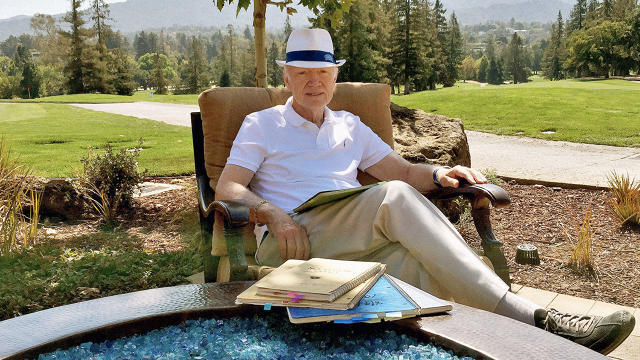
One thing McKenna didn’t think of himself as doing was recording history. But the notes he took in 1976 are the Dead Sea Scrolls of Apple marketing—a remarkable, unseen snapshot of what the company was in its earliest days, and what it hoped to become. He was nice enough to share them with me, so I could share them with you on Apple’s 40th birthday. But first, a little backstory is in order.
It Started With Silicon
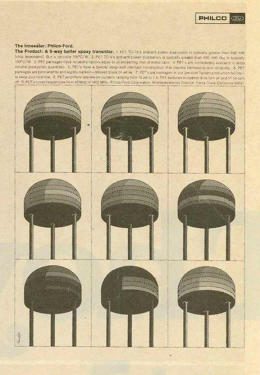
McKenna, a native of Pittsburgh, got his start in that city working for a producer of technical publications aimed at engineers. Still in its employ, he ventured west to Silicon Valley—well before anyone called it Silicon Valley—in 1963, when when the region’s tech economy centered around semiconductor startups. He found a marketing gig at one of those startups, General Micro-electronics, and “saw the whole process from molten silicon to a calculator, all under one roof,” he remembers. “My MBA in the industry was GME.” The ads he spearheaded there, with an emphasis on striking graphics over technical minutiae, presaged work he’d do in the years to come.
McKenna also spent time as an early employee at National Semiconductor before founding his own marketing, advertising, and public relations consultancy in 1970. In 1971, the fledgling Regis McKenna, Inc. signed up Intel as a client. Only three years old and not yet one of the world’s best-known corporations, it was still a plum assignment: The company was a major supplier of memory chips and had created the world’s first microprocessor, the 4004.
“The microprocessor was a revolutionary device,” McKenna says. “The engineers were no longer picking components to put on a circuit card they’d have to test and iterate many, many times. Now you were programming something, and it changed the way engineering development was done. The engineers didn’t initially buy into it—they liked what they were doing, and they had a certain amount of power.”

Because microprocessors were such a radical shift for the electronics industry, marketing was a primary form of education about their possibilities. Rather than addressing only engineers, RMI’s ads aimed to reach the executives who might see the new technology as a money-making opportunity. And even though they promoted highly technical products, they did so using uncommonly exuberant art, typography, and language—the stuff of consumer magazines, not scientific journals.
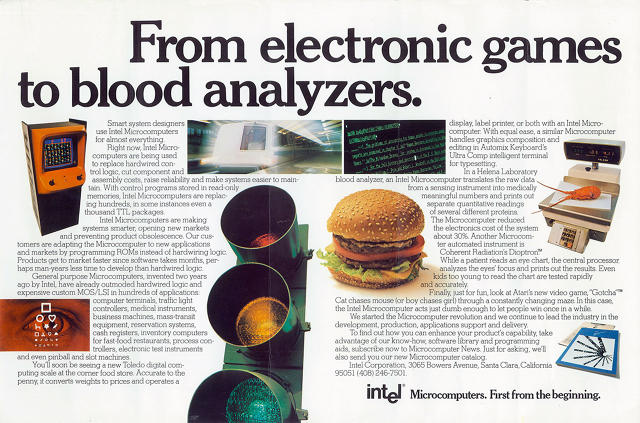
In all, “I think we were doing 50, 60, or more ads a year,” McKenna recalls. “Because Intel, for every new product, would want an ad.”
Among the people who saw the ads and were impressed was Steve Jobs, the self-appointed director of marketing of tiny Apple Computer, Inc. He’d already placed a small black-and-white ad for the company’s first system, the Apple-1, in an issue of Interface, a leading computer magazine; except for a rather glaring typo, it was adequate by the rudimentary standards of 1970s computer-magazine ads. Jobs, his ambitions for Apple’s branding already running a lot higher than small black-and-white ads, wondered: Who created these campaigns for Intel, and could they help him promote the Apple II, which Wozniak was in the midst of engineering? He called the chip maker, learned that they were RMI’s work, and ended up talking to Frank Burge, a McKenna associate responsible for feeling out potential clients.
The Apple Opportunity
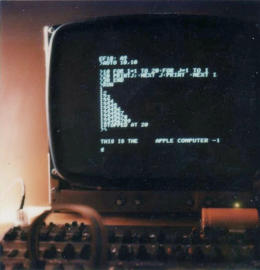
In the summer of 1976, the Apple-1 was brand new and almost nobody had heard of Apple or its system. Actually, few people outside of an obsessive group of proto-geeks knew about personal computers at all: The industry had only taken shape the previous year, centered around MITS’s Altair 8800.
Apple’s challenge, then, was less about convincing people to choose its computer over a competitor’s model than it was showing what personal computers were and what they could do. That project was right up McKenna’s alley. “I had some experience in trying to create a market for things with the microprocessor, which was always looking for bigger and bigger markets,” he says.
RMI had also done work for some other companies in the emerging PC ecosystem, including Paul Terrell’s pioneering Byte Shop chain. It happened to be the first retailer of Apple computers, having placed an order for 50 Apple-1 units, which—in a move that was not standard practice at the time—it had the company deliver as fully assembled boards rather than solder-it-yourself kits.
Even with RMI’s relevant expertise and interest in personal computers, it still wasn’t at all obvious that a dinky operation like Apple had any potential as a client for its services. Michael Moritz’s The Little Kingdom (1984), the first book-length history of Apple, quoted Burge as thinking to himself as he drove to the Jobs garage, “What’s the least amount of time I can spend with this clown without being rude, and then get back to something more profitable?”
Another member of McKenna’s team, Don Kobrin, also ventured to the garage and then met with Jobs at RMI’s office. He documented his impressions of those discussions in a memo dated June 22, 1976.
You really should read it in its entirety:
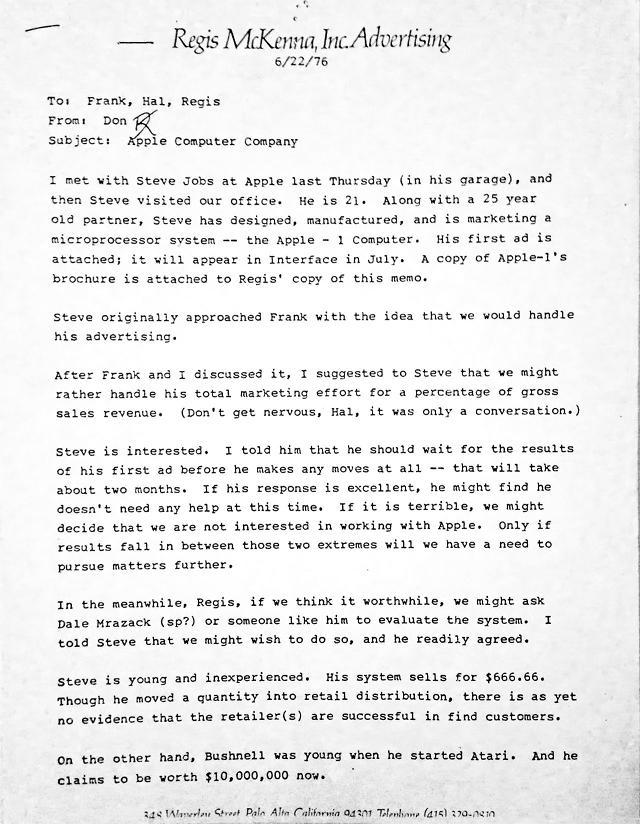
Kobrin’s take on Apple didn’t exactly burble with enthusiasm. Instead, he kicked the can down the road by saying that the startup might turn out to be either too successful or not successful enough to be an attractive prospect for RMI’s services. If a deal was struck, he floated the tantalizing possibility of RMI handling Apple’s marketing in return for “a percentage of gross sales revenue.” Today, McKenna stresses that any theoretical arrangement would have involved a cut of Apple II sales, not equity in Apple Computer, was outside of Kobrin’s purview to negotiate, and would never would have flown once Apple took on outside investors. He’s okay with that. “My company was young. I couldn’t afford to pay people’s salaries and have them work for free on spec. It would have been stupid.”

“Steve is young and inexperienced,” Kobrin warned, back in the era before it was quite so apparent that young, inexperienced entrepreneurs can do astounding things. (Bill Gates and Paul Allen had already started a company named “Micro-Soft” but were not yet titans of industry; Mark Zuckerberg wouldn’t be born for another eight years.) He also noted that there was no evidence yet that there was a market for what Apple was selling. Then again, the memo concluded, Atari founder Nolan Bushnell—who, unbeknownst to Kobrin, was weeks away from selling his company to media conglomerate Warner Communications—was allegedly worth a lofty $10 million.
When the two Steves finally made it past the gauntlet and met with Regis McKenna Himself—as he was famously dubbed on his business card as well as that rubber stamp—it still wasn’t instantly clear they were destined to team up. (McKenna says that when RMI was new and just a one-man outfit, a position such as “President” would have been presumptuous; the guy he hired to design his business card and letterhead added the “Himself” as a title, and it stuck.)
“Wozniak brought an article he was writing about what became the Apple II,” McKenna says. “It was pretty jargon intensive; he was talking to the engineers.” Selling the new computer, McKenna felt, would require explaining it to the uninitiated. “I told that to Wozniak, and he got pretty inflamed about it. I said, ‘There’s nothing I can do for you. Goodbye.’ He left, but Steve came back.”
Sans Woz, McKenna was impressed by Jobs’s intuitive sense of marketing. “Not from the first meeting, but the second meeting,” he clarifies. “He didn’t know exactly how to implement it, but he had a way of articulating what the personal computer could be.” Having overcome Burge’s skepticism and Kobrin’s caution, Apple became an RMI client.
Apple Gets Serious
All this was happening during a period when Jobs and Wozniak were rapidly putting together all the required pieces to turn Apple from a garage project into a real company. During McKenna’s early discussions with Jobs, he referred him to his former National Semiconductor boss, Don Valentine, who had become one of the Valley’s leading venture capitalists. In turn, Valentine introduced Jobs to Mike Markkula, who McKenna had known at Intel. Markkula began helping Jobs and Wozniak devise a business plan for Apple, and ended up so impressed with the Apple II’s potential that he put in $91,000 of his own money and guaranteed a $250,000 line of credit in return for a one-third share of the company, which was incorporated as Apple Computer, Inc. on January 3, 1977. He also insisted that Wozniak quit his engineering job at HP to work full-time on Apple.
The startup secured its first actual office space on Stevens Creek Boulevard in Cupertino and took occupancy in January 1977, putting down stakes in the city it would eventually make famous, and continues to call home today.
Now, about those notes. McKenna took them on December 4, 1976, as the company was beginning to plan a rollout for the Apple II—or “Apple 2,” as he called it—at the first West Coast Computer Faire at San Francisco’s Civic Auditorium on April 16 and 17, 1977. His handwritten pages, which begin with the double-underlined heading “Who’s Apple,” are terse, sometimes enigmatic, and occasionally just plain illegible; even he can’t make out every word he wrote nearly 40 years ago. All of which just serves to make them more fascinating.
Here they are (click to blow them up for easier reading):
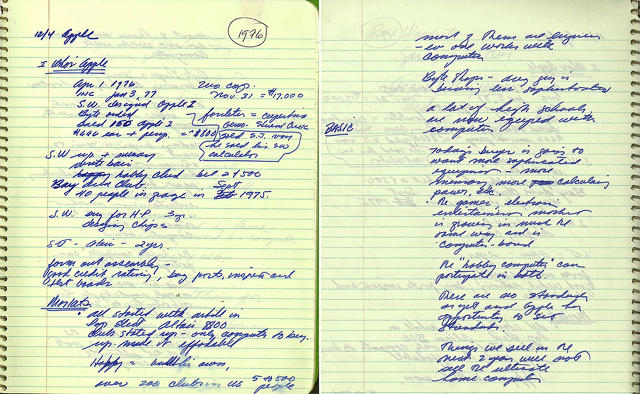
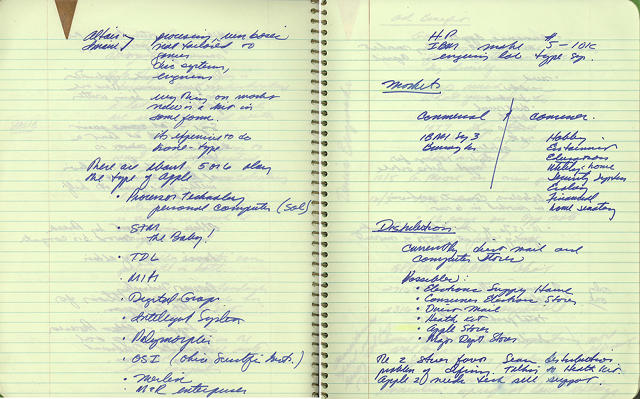
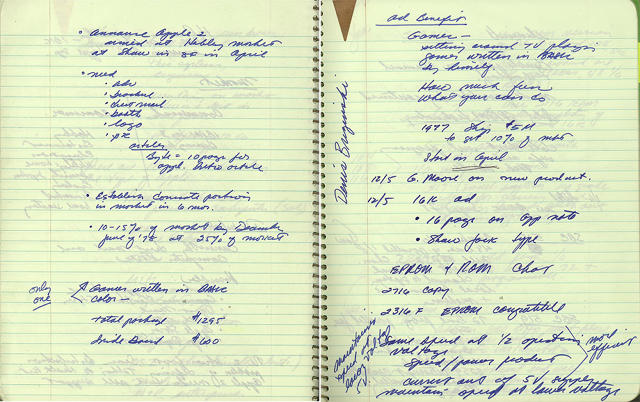
McKenna’s notes are in part a history of where Apple and the entire personal computing industry had been, and in part a blueprint for where they could go. In the most succinct possible fashion, he covered a lot of ground. Such as:
The founders’ résumés, such as they were. McKenna noted Wozniak’s and Jobs’s previous experience in the electronics business, which didn’t require much wordage (“S.W. eng for H-P 3 yr. designing chips, S.J. — Atari — 2 yrs.”). In a detail later to become legendary, he recorded how Woz and Jobs funded the company by selling a calculator and a van, respectively.
The Apple-1 upshot. The notes included some salient points about Apple’s first computer: The fact that Steve Wozniak designed it, its $666 price tag, the Byte Shop’s order, and total sales to that point of 150 units.
The market as it stood. “[It] all started with an article in Pop Elect [Popular Electronics],” McKenna wrote. The article, in the magazine’s January 1975 issue, unveiled the Altair 8800 microcomputer and told readers how to acquire the necessary components as an affordable kit. Now there were over 200 computer clubs in the U.S., he continued, with from 5 to 500 members apiece.

The Altair and its popular clone, the IMSAI, appealed to engineers and weren’t optimized for games, McKenna wrote: “Everything on market now is kit in some form.” He lists eight Apple rivals: Processor Technology (manufacturer of the SOL), Star (responsible for the excellently named “The Baby!”), TDL, MITS, Digital Group, Intelligent Systems, PolyMorphic, Ohio Scientific, MiniTerm (maker of a graphics board called Merlin), and M&R Enterprises. As it turned out, none of those companies and their products proved to be serious long-term competition for the Apple II.
When the system launched in 1977, two other machines would join it to make up the big three of the first generation of truly plug-and-play, mass-market microcomputers: Radio Shack’s TRS-80 and Commodore’s PET 2001. But they remained unannounced in late 1976, and unmentioned in McKenna’s notes.
Then there was IBM. McKenna referenced it and Hewlett-Packard, but only to note that they cater to engineers with machines that cost $5,000 to $10,000, far afield from the Apple II’s intended market. The first IBM PC, which would prove an epoch-shifting success when it arrived, was more than four years away—not yet on IBM’s radar, let alone Apple’s.
The market as it might evolve. McKenna divvied the markets for personal computers into two lists—”commercial” and “consumer”—and put most of them in the second column, including hobby, entertainment, education, security, “home secretary,” and other uses. Most of them did turn out to be popular applications for the Apple II once it hit the market.
The retail possibilities. McKenna noted that PCs were sold by mail order and through computer-centric shops, and then listed some other locations that might make sense for the Apple II:
Distribution
Currently direct mail and computer stores
Possible:
- Electronic Supply House
- Consumer Electronic Store
- Direct Mail
- Heath Kit
- Apple Stores
- Major Dept Stores
Wait, “Apple Stores?” In 1976? Yes, indeed. If the Apple II was going to bust into the big time, it would need, one way or another, to stretch the boundaries of the PC retail market as it existed in 1976 and 1977, when even chains such as Terrell’s Byte Shops catered to first-generation computer hobbyists, not the masses. “I kept on bringing up the Apple Stores because there was no outlet,” McKenna says. “It only made sense that you would sell them through your own stores.” The concept proved rather successful once the company tackled it in earnest a mere quarter of a century later.
The positioning for the Apple II. With its fancy color graphics, audio and animation capabilities, and bundled Pong-style paddle controllers, Apple’s new machine was going to be by far the most game-friendly computer released until that time. It was also a power user’s machine, and was designed from the start to be a platform that other companies could build upon. “The Apple II had seven slots, so it was adaptable,” McKenna says. “It was an open system. A lot of third parties could develop their own applications and take it into different markets for us.”
McKenna’s notes strategized out how the Apple II could succeed by catering to multiple constituencies. They didn’t entirely predict what actually came to be—business productivity became a major market for the system, especially after the arrival of the first spreadsheet, Dan Bricklin and Bob Frankston’s VisiCalc, in 1979—but they came surprisingly close:
Today’s buyer is going to want more sophisticated equipment—more memory, more calculating power, etc.
The games, electronic entertainment market is growing in much the same way and is computer-based
The “hobby computer” can participate in both
There are no standards as yet and Apple has opportunity to set standards
This section ends with a thought that seems to be a tad garbled: “Things we sell in next 2 years will not sell the ultimate home computer.” Today, McKenna isn’t 100% positive what he meant. But he says that Steve Jobs was insistent from the start that the Apple II wasn’t a fully realized personal computer, but rather one step on a journey toward simpler, more appliance-like devices—a vision that led to the Macintosh in 1984, and the iPad 26 years after that.
The beginnings of a game plan. Toward the end of his notes, McKenna jotted a to-do list for the new Apple computer’s launch, referencing a Byte magazine story by Woz that may have been the jargony article that inspired their earlier tiff:
Announce Apple 2 aimed at hobby market at show in SF in April
Need
- ads
- brochure
- direct mail
- booth
- logo
- articles
- Byte =10 pages for appl. intro article
An objective. McKenna even set down some aggressive sales goals for the Apple II—which, thanks to competition from the much cheaper TRS-80 and PET 2001, it didn’t meet, though it hardly mattered in the long run:
Establish dominant position in market in 6 mos.
10-15% of market by December
June of ‘78 at 25% of market
On his last page of notes, he roughed out a concept for an ad:
Ad Benefit
Games—
sitting around TV playing games written in BASIC by himselfHow much fun
What you can do
He then reiterated an ambitious sales goal: selling $5 million worth of computers in 1977 to capture 10% of the market. “Start in April,” he wrote. And then, halfway through a page, he segued to an unrelated project: planning out an ad campaign for Intel memory chips.
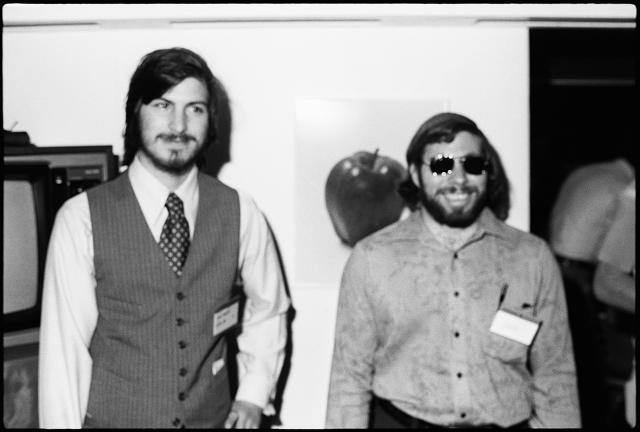
The Plan Becomes Reality
Within months of McKenna’s December note-taking session, he’d checked off all the items on his marketing to-do list. Apple got a new corporate logo (designed by RMI art director Rob Janoff, and eventually to become iconic itself), made a splash at the West Coast Computer Faire, and ran its first Apple II advertising in publications such as the June 1977 issue of Byte. (Other early ads would also show up in magazines as far afield from the gearhead market as Playboy—a statement in itself about Apple’s aspiration to reach a bigger, broader market than any PC before it.) RMI even got involved in aspects of the Apple II that fell outside the boundaries of conventional marketing; for instance, it consulted on the machine’s strikingly consumery case design.
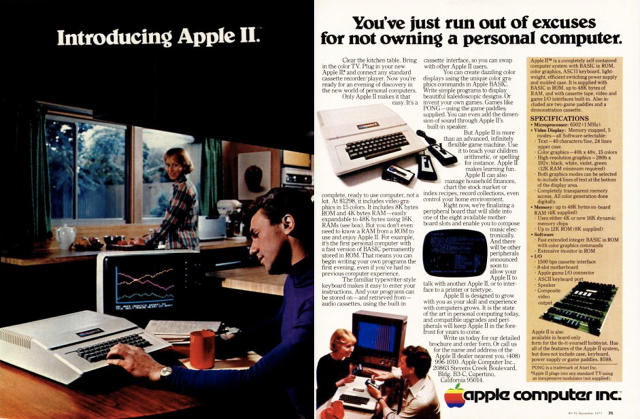
Apple introduced itself with an ad that was a lot slicker than a typical computer-magazine ad of the day, but also dense with information. Its left-hand page was devoted to a photo of a man in a blue turtleneck sitting at his kitchen table, thoughtfully monitoring the Dow Jones Industrial Average on an Apple II. (Well, sort of—he’s stretching to perform one-handed typing on a distant computer and ignoring the display altogether, an attractive presentation of the hardware apparently being more important than realism.) On the ad’s right-hand side were a bevy of details about the computer’s specs, applications from education to home automation, expansion options, and the joys of programming in BASIC. At a time when monthly magazines were almost the only venue Apple had to promote itself, the ad was like a keynote presentation crammed into a double-page spread.
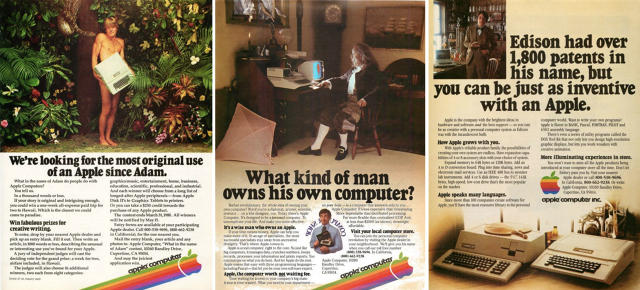
RMI’s ads are the most lasting remnant of McKenna’s campaign for the Apple II, and still easy enough to track down on the Internet. But the PR push was at least as important, and in some ways the more daunting part of the rollout. Later on, Apple could throw a media event and have the press clamoring to get in. But in 1977, it wasn’t just that Apple was obscure; mainstream business and consumer publications hadn’t yet started paying attention to Silicon Valley startups, period.
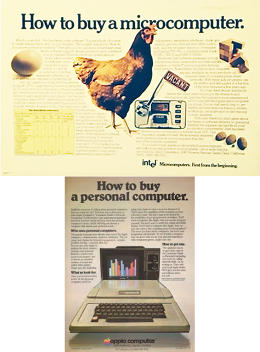
“There was no media on the West Coast then,” McKenna says, sounding a little frustrated even at the memory. “The Wall Street Journal would not run an article about a company that was not listed on the New York Stock Exchange until about 1983.”
His secret weapon turned out to be Steve Jobs. “I took Steve and put him on a plane with me to go all over,” he says. “His personality was what captured people. They didn’t know if he was real or not, but he was smart and articulate and enthusiastic. He was a different kind of person than the president of IBM.”
McKenna, who had seen Intel boom from $9.4 million to $226 million in annual revenue between 1971 and 1976, didn’t think of Apple as having made it until it reached a nice, big yearly sales figure of its own. “When we hit $100 million,” he says, “that said we had something.” Apple got there during its 1980 fiscal year, its last as a private company. In 2015, it accomplished the same feat, adjusted for inflation, more than twice each day.
After The Apple II
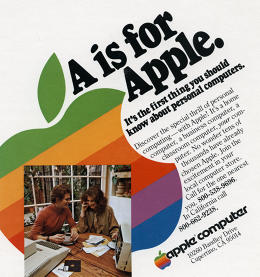
In 1981, McKenna sold his advertising business to his friend and former colleague Jay Chiat of Chiat/Day, the agency that went on to produce the legendary “1984” commercial that introduced the Macintosh. (It continues to do work for Apple today.) But even though McKenna was out of the ad game, he was still deeply embedded in Apple. During the 1980s, he participated in its weekly executive staff meeting (despite not being an Apple employee), spent years developing the marketing plan for the Mac, and was a firsthand witness to Steve Jobs’s agonizing 1985 ejection from the company he cofounded. (McKenna tried to broker a deal for Jobs to undo his resignation and stay at Apple as chief technology officer—a proposition which, it turned out, proved alluring neither to Jobs nor most of Apple’s management.)
RMI continued to provide public relations services for Apple until 1995. Even after McKenna left the ongoing practice of PR, he kept in touch with Jobs, who returned to Apple in 1997 and sought his counsel during the 2010 iPhone kerfuffle known as “Antennagate.” He’s also written books, advised businesses and nonproft organizations, and made investments (including putting up some of the initial funding for a magazine called, ahem, Fast Company).

For all that’s changed about Apple and its products since McKenna took his 1976 notes, it’s a breeze to connect the dots between the image he shaped for the Apple II and the company’s present-day view of itself as communicated in its messaging. (The first Apple II brochure, prepared for that 1977 computer show, had a declaration on its cover—”Simplicity is the ultimate sophistication”—which would be perfectly at home in an ad for a MacBook, iPhone, or Apple Watch.) Which led me to ask him: What did he think of Apple’s current marketing?
I expected him to respond with a critique of its ads, but instead, he made a different point—that anyone who sees Tim Cook, Jobs’s successor as Apple CEO, as a grand master of efficient supply-chain logistics but not a savvy marketer has a pretty shallow understanding of marketing. “Logistics means marketing,” he told me. “Having the product that you want, when you want it, and where you want it is marketing. I think Tim’s a great guy, and I don’t think people appreciate him enough.”
That would be an intriguing take from anybody. Coming from Regis McKenna Himself—the man who figured out how to market Apple in the first place—it feels less like an opinion and more like the last word on the subject.
Related: The History of Apple in Under 3 Minutes
Fast Company , Read Full Story
(124)














